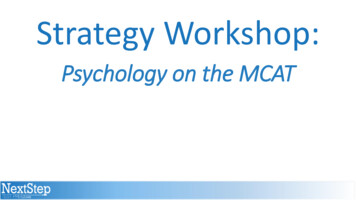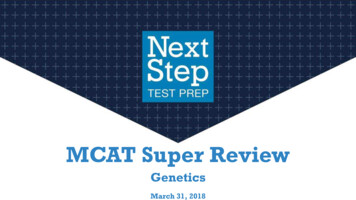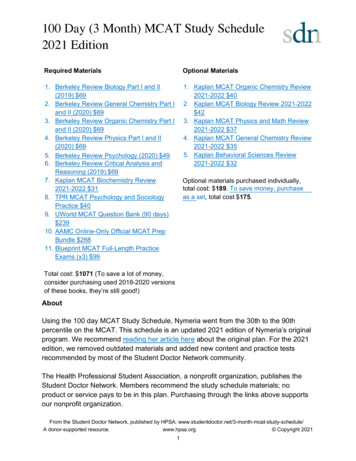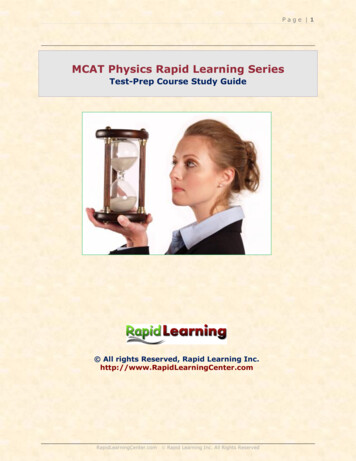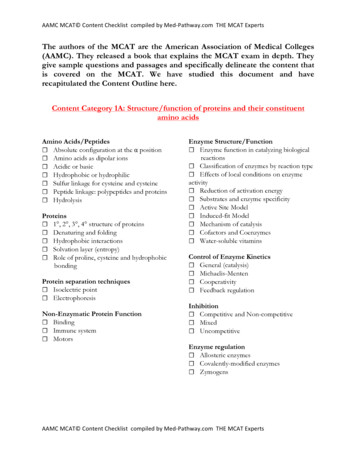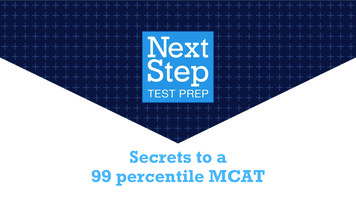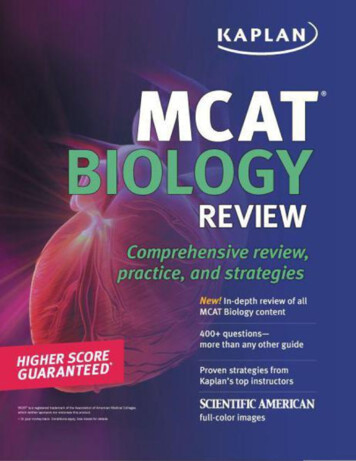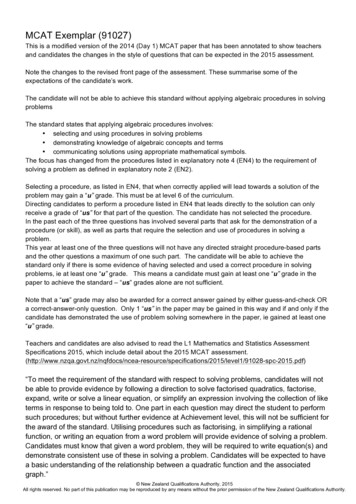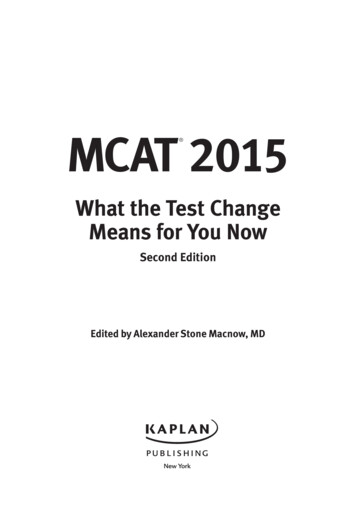
Transcription
MCAT 2015 What the Test ChangeMeans for You NowSecond EditionEdited by Alexander Stone Macnow, MD00 MCAT2015 FM.indd 17/15/14 3:18 PM
AcknowledgmentsThis book was a collaborative effort on the part of Kaplan’s MCAT team:Samantha Fallon; Owen Farcy; Adam Grey; Aaron Lemon-Strauss; KeithLubeley; Alexander Stone Macnow, MD; Petros Minasi, Jr.; and DeeangeleePooran-Kublall, MD, MPH.Special thanks to Mikhail Alexeeff; Erik Bowman; Kim Bowers; M. DominicEggert; Tyler Fraser; Dan Frey; Robin Garmise; Rita Garthaffner; JoannaGraham; Allison Harm; Maureen McMahon; Maria Nicholas; John Polstein;Neha Rao; Rochelle Rothstein, MD; Larry Rudman; Amjed Saffarini; Scott Safir;Thomas Sargent; Sylvia Tidwell Scheuring; Carly Schnur; Logan Stark; StephenSylwestrak; Lee Weiss; and the countless others who made this project possible.MCAT is a registered trademark of the Association of American MedicalColleges, which neither sponsors nor endorses this product.This publication is designed to provide accurate and authoritative informationin regard to the subject matter covered. It is sold with the understandingthat the publisher is not engaged in rendering legal, accounting, or otherprofessional services. If legal advice or other expert assistance is required, theservices of a competent professional should be sought. 2014 Kaplan, Inc.Published by Kaplan Publishing, a division of Kaplan, Inc.395 Hudson StreetNew York, NY 10014All rights reserved. The text of this publication, or any part thereof, may not be reproduced in any manner whatsoever without written permission from the publisher.Printed in the United States of America10 9 8 7 6 5 4 3 2 1ISBN: 978-1-61865-622-300 MCAT2015 FM.indd 27/15/14 3:18 PM
T a b l e o f C o ntentsIntroduction viiChapter 1: Why Was the MCAT Created? (And What’s It All About?) 1A Brief History of Medical Education and the MCAT. 1Five Common Misconceptions About the MCAT. 6Chapter 2: What MCAT 2015 Will Look Like 13Test Length and Sections. 14Passages and Content. 15Questions and Skills. 16Scoring. 16A Timeline of the Test Changes. 18Chapter 3: Why the MCAT Is Changing 19Changes in Content. 20Biologically-Based Passages. 22A Longer (and More Powered) Exam. 22Chapter 4: Medicine: Now and in the Future 25Changes in Content. 25Biologically-Based Passages. 30A Longer Exam. 31iii00 MCAT2015 FM.indd 37/15/14 3:18 PM
Table of Contents Chapter 5: What Will Stay the Same 33The Current Premedical Curriculum Is Still Important. 34(Almost) All the Current Science Topics Are Being Kept. 36Science and Strategy Will Be Tested in Combination. 39“Verbal Reasoning” Is Not Really Changing Much. 40The Test Is Still Extremely Important . 41Chapter 6: What Will Be Removed 43A Few Low-Yield Science Topics Are Being Removed . 43Certain Science Subtopics Are Being Altered . 45MCAT 2015 Will Have (Slightly) Fewer Physics Questions. 46Chemistry and Physics Will Be Tested Only inthe Context of Biological Systems. 47Chapter 7: What Will Be Added 49The Behavioral Sciences Section (“Psych/Soc”). 49Biochemistry. 55Test Day Is Getting (a Lot) Longer. 58Chapter 8: Ask a Psychometrician 61Chapter 9: Preparing for MCAT 2015 73Recommended Coursework and Scheduling. 74Preparing for Both Exams: Biology, Chemistry, and Physics. 76Preparing for MCAT 2015: Biochemistry, Psychology,and Sociology. 82A Few Thoughts on Verbal Reasoning/CARS. 87iv00 MCAT2015 FM.indd 47/15/14 3:18 PM
Table of Contents Chapter 10: What If I Don’t Have Time for the Prerequisites? 89Study Options for the New Material for MCAT 2015. 91Gauging Your Study Materials. 97Chapter 11: The Skills That MCAT 2015 Will Test 105Scientific Inquiry and Reasoning Skills.106Cars Skills.114Chapter 12: Sample Questions and Test-Taking Strategies 121Chemical and Physical Foundations of Biological Systems(Chem/Phys).121Critical Analysis and Reasoning Skills (CARS). 133Biological and Biochemical Foundations of Living Systems(Bio/Biochem).144Psychological, Social, and Biological Foundations of Behavior(Psych/Soc).158Chapter 13: MCAT 2015 Practice Test 169Chapter 14: Interpreting Your Practice Test Score 171Using the Kaptest Interface.172How to Review the Practice Test.174Chapter 15: A Few Final Thoughts 183v00 MCAT2015 FM.indd 57/15/14 3:18 PM
00 MCAT2015 FM.indd 67/15/14 3:18 PM
IntroductionAnd now it starts: your long yet fruitful journey toward wearing awhite coat. Proudly wearing that white coat, though, is only part ofyour motivation. You are reading this book because you want to be ahealer.Studying for any test isn’t fun, but it doesn’t have to be a nightmare,either.Studying for a test that is still undergoing its final development,however, is even more of a challenge.We are at a unique point in the history of the MCAT. For the first timein over twenty years, the MCAT is undergoing a major foundationalchange. Sure, the current version of the MCAT itself has evolved froman eight-hour-long paper-and-pencil exam to a three-and-a-half-hourcomputer-based test—but the exam’s revolutionary change coincideswith a defining moment in medicine and healthcare. Medicine ischanging. Healthcare is changing. The skills that are valued in aphysician are changing. And the changes in the MCAT reflect atransformation in what is expected of incoming medical students.In this book, we have offered an interpretation for you, the student,of what this revolutionary change in the MCAT means for you, youreducation, and your future. We will start out with an overview ofthe context of this change, and then dive into the specifics of whatyou should know. Then, we will teach you how to approach this newexam through examples and strategies, culminating in the experienceof a practice version of the new MCAT along with thoughts on whatyou should consider as you move forward with your preparation.vii00 MCAT2015 FM.indd 77/15/14 3:18 PM
IntroductionHere, we share with you what we know about the new MCAT as itstands now, but you can expect that we will keep you informed as wecontinue to learn more about the changes to the exam.On behalf of everyone at Kaplan, congratulations on taking thesefirst steps toward wearing your own white coat, and welcome to thebeginning of your study of medicine.viii00 MCAT2015 FM.indd 87/15/14 3:18 PM
Ch a p t e r 1Why Was the MCATCreated? (And What’s ItAll About?)We stand now at the beginning of a new era in medical education.As citizens of this 21st-century world of healthcare, we arecharged with creating a patient-oriented, culturally competent, costconscious, universally available, technically advanced, and researchfocused healthcare system that is run by compassionate providers.Suffice it to say, this is no easy task. The development of problembased learning, integrated curricula, and classes in interpersonalskills are some of the responses to this demand for an excellentworkforce—a workforce of which you’ll soon be a part.Congratulations on taking your first step in the journey to (and through)medical school!A Brief history of medical educationand the mcatWhile our understanding of the human body (and, by extension, ourability to diagnose and treat disease) has increased exponentiallyover the last century, medical education is in a similar position nowto where it was one hundred years ago. Reeling from the atrocities of101 MCAT2015 Ch 01.indd 17/16/14 10:50 AM
Chapter 1Why Was the MCAT Created? (And What’s It All About?)World War I and the extreme morbidity it caused, the United Statesfound itself in the midst of a physician shortage. Further, the FlexnerReport,1 an oft-cited treatise published by Abraham Flexner in 1910,recommended significant changes to the education of premedical andmedical students alike. Most notably, the Flexner Report paved the wayfor the standardization of premedical curricula (the “three sciences” ofbiology, chemistry, and physics) and urged medical schools to find acommon and consistent method for evaluating prospective students.Flexner also reformed medical education once students were alreadyaccepted to medical school: he pushed for the standard four-yearcurriculum (two years of preclinical or laboratory science—such asanatomy, biochemistry, physiology, and pathology/pathophysiology—and two years of clinical experience). Prior to the Flexner Report,schools set their curricula with no external oversight or regulation, andstudents were often accepted with few or no academic credentials.In the wake of this treatise, and perhaps partially from changesinstituted because of the Flexner Report, attrition rates (the numberof students dropping out) at medical schools began to climb, and—by the middle of the 1920s—up to one-half of incoming studentswere gone before graduation day. This was haunting to the medicalcommunity, which found itself torn between needing more physiciansand needing more skilled physicians. How could medicine create arobust system for evaluating incoming students to assure medicalschools that they were accepting all-stars who would be able tocomplete the requirements of medical school? Enter the MCAT.From the Moss Test to 1991It was in this academic climate that psychologist–physicianFred A. Moss developed the test that bore his name, also known asthe Scholastic Aptitude Test for Medical Students (SATMS). This firstversion of the MCAT was composed of six to eight sections, eachof which tested a different skill; these included memory, scientificreasoning and knowledge, reading comprehension, and logic.1 Flexner A. Medical Education in the United States and Canada: A Report to the Carnegie Foundationfor the Advancement of Teaching (The Flexner Report). The Carnegie Foundation for the Advancementof Teaching. 1910.201 MCAT2015 Ch 01.indd 27/16/14 10:50 AM
Chapter 1Why Was the MCAT Created? (And What’s It All About?)The adoption of the Moss Test/SATMS as an admission credentialdirectly reflected the establishment and standardization of modernmedical education.As medical schools began to downplay the psychological testingaspects of the Moss Test/SATMS and focus more on contentknowledge and critical thinking skills, the test continued to evolve.In 1946, a four-part exam called the Professional School AptitudeTest was developed, with sections on quantitative and verbal skillsand on scientific content and application, as well as a sectiontermed Understanding Modern Society (later, General Information).This last section tested civics, economics, history, and sociology,making it somewhat similar to the new Psychological, Social, andBiological Foundations of Behavior section of MCAT 2015—and itprobably flowed from similar drives as those that motivated thecurrent test revision. Then as now, with an expanding Americanlandscape, ever-increasing in its diversity, the modern physicianmust understand the society in which he or she works.More subtle changes occurred until the early 1990s. The MedicalCollege Admission Test acquired its current name in 1948, GeneralInformation was dropped in 1977, and the scoring was adjusted froma scale of 200–800 to a scale of 1–15. Score reporting also changed,with individual scores from each science being provided rather thanone common score for all sciences.CHAPTER LINKSee Chapter 3 for information on why the MCAT is changing in2015. See Chapter 7 for information on what is covered in thenew Psychological, Social, and Biological Foundations of Behaviorsection. See Chapter 12 for examples of questions from thisnew section.301 MCAT2015 Ch 01.indd 37/16/14 10:50 AM
Chapter 1Why Was the MCAT Created? (And What’s It All About?)The Current MCAT: 1992 to January 2015The paradigm for MCAT questions changed dramatically in 1992,when passage-based questions became the predominant questiontype on the exam. This may have been, in part, a response to theaccusation that the MCAT was a memorization-driven, content-heavyexam. While the skills that the Association of American MedicalColleges (AAMC) are looking for are more thoroughly discussed laterin this chapter, the change to passage-based questions heraldeda need for test-takers to be able to absorb new information whiletaking the exam and then integrate that information with whatoutside knowledge they already had.The test sections were again changed, leading to the well-knownfour sections of today’s MCAT: Physical Sciences, Verbal Reasoning,Biological Sciences, and the Writing Sample (dropped in 2013).While the quantitative section was formally dropped in this same MCATrevision, the skills it tested (arithmetic, algebra, basic geometry andtrigonometry, formula manipulation, estimation, and basic probabilityand statistics) were distributed throughout the science sections.In 2007, the MCAT followed a number of other standardized exams2in becoming a computer-based test. For many students, this was awelcome change: the exam became nearly three hours shorter, at4 hours and 20 minutes of total testing time; further, many studentspreferred the ability to type their writing samples rather than havingto hand-write them. After all, doctors aren’t really known for theirperfect penmanship!Finally, this test revision marked a vast increase in the number oftimes the MCAT was offered per year. As a paper-and-pencil test, theMCAT was available only twice annually, in April and August, andstudents would fill giant lecture halls on their school’s campus totake the test. In contrast, the MCAT was offered 33 times in the 2014calendar year, including both morning and afternoon administrations;the AAMC’s partnership with Prometric limited the number of studentswho could take any one exam (the test centers are of limited size), but2 The first major standardized exam to become computer-based was the National Council LicensureExam (NCLEX), which made the switch as early as 1994. This is the certification examination for nurses.401 MCAT2015 Ch 01.indd 47/16/14 10:50 AM
Chapter 1Why Was the MCAT Created? (And What’s It All About?)increased the safety and security of the exam. It should be noted thatMCAT 2015 will be administered only 14 times during 2015. The AAMChas announced that it will partner with undergraduate universities tobe able to increase the number of available seats per administrationby offering the MCAT in a secured location on campus.The transition to MCAT 2015 could be felt by test-takers as early asJanuary 2013. This test is notably shorter: it’s dropped the WritingSample, which gives students an hour of testing time back (3 hours,20 minutes total testing time). This change was mostly due to thefact that admissions committees deemed this section by far the leastimportant when making admissions decisions and noted the difficultyof analyzing the Writing Sample score, which was given as a letteron a scale from J to T, with T being the highest, next to the numericalscore of the multiple-choice section, which ranges from 3 to 45, with45 being the highest.The January 2013 administrations of the MCAT also marked the firsttime the AAMC had tested material for MCAT 2015 on students atlarge. Following the Biological Sciences section, students who did notvoid their scores could choose to participate in the Trial Section—a45-minute, 32-question, unscored section featuring questions onthe new material for MCAT 2015: biochemistry, psychology andsociology, and biologically-based chemistry and physics. As a rewardfor put[ting] forth a good-faith effort,3 test-takers received a 30Amazon.com claim code and feedback on their performance in thesection compared to that of the others who also participated.MCAT 2015: Spring 2015 to 2030(?)In this new era in medical education, the AAMC revisited the MCATto see how it could play a role in arming the next generation ofphysicians for our developing healthcare system. In 2008, the AAMCcreated the MR5 (MCAT Review #5) committee, tasked with assessingthe MCAT and recommending appropriate changes to increase theexam’s relevance for students and admissions committees alike.3 Trial Section. AAMC.org.501 MCAT2015 Ch 01.indd 57/16/14 10:50 AM
Chapter 1Why Was the MCAT Created? (And What’s It All About?)How and why the MCAT is changing in 2015 is covered extensively inthe next two chapters, so we’ll leave those details for later. But wedo know that this exam is here to stay. In the standardized testingworld, it’s considered good practice to revisit and review an examabout every ten to fifteen years; as the AAMC reports, this newversion of the exam is likely to remain until at least 2030.CHAPTER LINKSee Chapter 2 for information on how the MCAT is changing in 2015.See Chapter 3 for information on why the MCAT is changing in 2015.IMPORTANT POINTMCAT 2015 is here to stay. This new version of the exam is likelyto remain until at least 2030.Five common misconceptionsabout the mcatThe utility of the MCAT as a testing resource, its role in admissionsdecisions, and its ability to predict academic success have beenstudied extensively, both by the large research arm of the AAMC andby outside researchers. While this information is generally availableto the public, misinformation and misconceptions about the MCAT liveon in internet forums and word-of-mouth. We present five commonmisconceptions about the purpose of the MCAT and what it’s testing.#1The MCAT is a content test, summingup the courses I took in undergrad.Yes, the MCAT does contain a lot of content—eight semesters’worth of science (two semesters each of physics, general chemistry,organic chemistry, and biology). This will only increase with the new601 MCAT2015 Ch 01.indd 67/16/14 10:50 AM
Chapter 1Why Was the MCAT Created? (And What’s It All About?)MCAT 2015 exam (all of the courses needed for the current MCAT,plus a semester each of biochemistry, psychology, and sociology).But while you need to know the Doppler effect, the Henderson–Hasselbalch equation for buffers, acyl substitution reactions, andthe hormones that govern the menstrual cycle (sometimes called theHPO, or hypothalamic–pituitary–ovarian axis), content knowledgealone is not sufficient for excellent MCAT performance. Rather,critical thinking—the ability to reason, to integrate, to look at aproblem in a creative way and find efficient methods to solve it—isthe primary driver of a high score. After all, Skill 2 (Critical Thinking)underlies 45% of the questions on Test Day.Why is this? Well, schools can get a sense of your content knowledgeby looking at your undergraduate or postbaccalaureate grades. Butthe thinking process and ability to use such knowledge is not testedevenly across schools; thus, the MCAT acts as a great equalizer,testing your ability to think—and not just memorize. And perhapsmost importantly, critical thinking underlies your ability to succeedas a physician. Consider the patient coming into the emergencydepartment with acute abdominal pain of four hours’ duration. Sure,you could memorize all of the possible diagnoses, workups, andtreatments for every condition that causes abdominal pain—or couldyou? The differential diagnosis (list of likely causes) is extensive; butconsidering the age of the patient, the patient’s sex, comorbidities(other illnesses he or she has), and the description of the pain, youcan reason out what questions would be best to ask to help youdetermine the diagnosis.MED SCHOOL INSIGHTIn some medical schools, students play “100 Causes of AbdominalPain.” And there really are at least a hundred: everything fromabdominal aortic aneurysm (AAA, an enlargement—and potentiallya rupture—of the aorta in the lower back) to a Zuckerkandl organpheochromocytoma (a particular epinephrine-producing tumorlocated outside the adrenal gland). How could you choose whichdiagnosis is correct for a patient without using critical thinking?701 MCAT2015 Ch 01.indd 77/16/14 10:50 AM
Chapter 1Why Was the MCAT Created? (And What’s It All About?)The MCAT likes to test the exceptions, theunusual examples, and the esoteric content.#2This is a common misconception about the MCAT that leads manypremedical students to take additional coursework that is notnecessary for success on Test Day. While advanced inorganicsynthesis, anatomy and physiology, and modern physics can showup in an MCAT passage, the outside knowledge required by theAAMC still adheres to the eight-semester sequence previouslymentioned.It’s certainly not a bad idea to take more advanced sciencecourses if your schedule permits—gaining an understanding ofanatomy and physiology before you get to medical school willundoubtedly make cadaver dissection a bit easier—but recognizethat these courses should not be taken specifically for the MCAT.All the information necessary to answer the questions will be inthe passages or in outside knowledge as listed by the AAMC’scontent outlines.FIND MORE ONLINEThe AAMC content outlines list the outside knowledge studentsare expected to have before taking the current MCAT. Theselists are narrower than many students expect; note the absenceof rotational inertia or momentum, alkene reactions, andphylogeny.801 MCAT2015 Ch 01.indd 87/16/14 10:50 AM
Chapter 1Why Was the MCAT Created? (And What’s It All About?)So why does it feel like the MCAT is asking questions you’ve neverseen before? Remember—it’s all about critical thinking: the MCATis a master of testing basic material at a high level, especially byintegrating the various sciences. For example, the MCAT couldexplain the cardiovascular system as a group of parallel resistorsand apply circuit properties to our understanding of heart failure,hypertension, and sepsis.#3Passages are included on theMCAT to slow me down.Students sometimes assume that passages are included asbackground information for those unfamiliar with the content coveredin a given set of questions. Therefore, they misinterpret the passagesas merely introducing a time crunch rather than being a critical partof the test.The change to passage-based questions in 1992 came from a farmore sophisticated drive than a wish to challenge students’ timemanagement abilities. The addition of such questions requiresstudents to integrate new information with the corpus of knowledgethey already have and see how they jibe. MCAT passages willfrequently challenge common assumptions about a given scientificprocess or introduce an experiment testing the validity of a scientificidea. Only by reading the passage and actually observing whathappens can you be prepared for the accompanying questions.Medicine is a field that requires continuous learning. Ouradvancements in technology belie our advancements inunderstanding the human body. Much like you will have to integratenew information with what you already know while reading MCATpassages, you will have to stay abreast of the newest studies inmedicine through academic journals, conferences, and trainings.Admissions committees (and your future patients!) are very interestedin your ability to adjust to new data, to manipulate them, and toabsorb them into your schemata of how the world works.901 MCAT2015 Ch 01.indd 97/16/14 10:50 AM
Chapter 1Why Was the MCAT Created? (And What’s It All About?)#4I’ll never use this informationagain—especially as a doctor!The concepts and critical thinking that underlie the MCAT are bothimportant to decisions you’ll make as a doctor. We’ve discussedthe critical thinking, but why are these concepts important? There’sprobably no better way to prove it than with a few examples.When a patient breaks a bone, the translational forces and torquesstill acting on the bone can be used to predict what structures mightbe damaged if the fracture is angulated or displaced (moved from itsstarting position). We also must understand these forces and torquesif we are to reset the bone correctly.Acid and base chemistry dictates the blood disturbances we seein everything from chronic obstructive pulmonary disease (COPD)to altitude sickness to acute kidney failure. We further use theprinciples of acid–base chemistry and the semipermeable membraneto increase the excretion of toxins; a patient with an overdose ofaspirin (acetylsalicylic acid) can excrete more of the toxin when it isdeprotonated because it takes on a negative charge and thus cannotcross the cell membrane to reenter the body from the renal tubules.Urinary alkalinization (when titrated correctly) can therefore helpavoid a toxic overdose.The continuity equation and Bernoulli’s principle explain thepathophysiology of a number of valvular and vascular disorders inthe body. In fact, one of the diagnostic findings in valvular stenosis(the narrowing of a heart valve) is an increased blood linear flowrate. Physicians know from the continuity equation that as crosssectional area decreases, linear flow speed increases (assuming aconstant flow rate/cardiac output).Isomerism is a critical consideration in drug design. Consider theproton-pump inhibitor omeprazole (used for gastroesophageal refluxdisease, peptic ulcers, and other acid-excess states). When thismedication was going to come off patent, a new drug was developed:esomeprazole. Take a look at the names there. Omeprazole is a1001 MCAT2015 Ch 01.indd 107/16/14 10:50 AM
Chapter 1Why Was the MCAT Created? (And What’s It All About?)racemic mixture; esomeprazole is only the (S)-enantiomer ofthe same drug. Yet the receptor here is achiral! Thus, for a hugedifference in cost, the patient experiences very little difference whentaking one drug vs. the other. A patient will be thankful when thetherapy you prescribe doesn’t break the bank!There are hundreds of additional examples. But, to be clear, drawingout these connections between science and medicine and makingthem more explicit are critical components of MCAT 2015.#5The MCAT is not particularly predictiveof my success in medical school.While it may have been a bit harder to draw a correlation betweenyour SAT score and success in undergrad, the MCAT has beendemonstrated multiple times to be highly predictive of first- andsecond-year grades in medical school and success on the UnitedStates Medical Licensing Examination, Step 1 (USMLE, or the“Boards”). A landmark study by Ellen Julian in 20054 found that theMCAT was 59% correlated with first- and second-year grades, 46%correlated with clerkship (third-year) grades, and 70% correlatedwith Step 1 scores. This was significantly higher than correlationswith undergraduate GPA alone, which were 54%, 36%, and 49%,respectively. The brief takeaway: dominating the MCAT bodes well foryour success in medical school.All in all, the MCAT has come a long way from its creation as theMoss Test in 1928. And as it continues to evolve in the 21st century,it remains a challenging—yet valid!—test. Together, we’ll master theMCAT, whether you take the current version or MCAT 2015. With that,let’s see what’s actually changing in the new exam.4 Julian ER. Validity of the Medical College Admission Test for predicting medical school performance.Acad Med. 2005; 80(10): 910–7.1101 MCAT2015 Ch 01.indd 117/16/14 10:50 AM
01 MCAT2015 Ch 01.indd 127/16/14 10:50 AM
Ch a p t e r 2What MCAT 2015 WillLook LikeYou bought this book to get a better sense of what MCAT 2015is going to look like. While AAMC-written practice exams will bereleased in fall 2014, the AAMC has provided a wealth of informationthrough their Official Guide to the MCAT2015 Exam.1 This documentcan be a bit dense to read, however, so we’ve distilled the majorstructural, content, and scoring highlights of the new exam.SectionScience TopicsNumber of Number ofQuestions MinutesBiochemistr
Published by Kaplan Publishing, a division of Kaplan, Inc. 395 Hudson Street New York, NY 10014 . MCAT 2015 Practice Test 169 . The Medical College Admission

